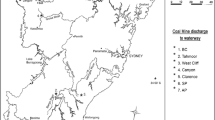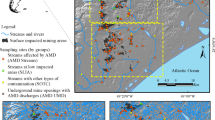Abstract
This study assessed the combined effects of seven large-scale gold mines, one manganese mine, and scattered artisanal gold mining sites on the quality of water in the Ankobra Basin in a geologically complex terrain. Water samples from streams, boreholes, hand dug wells, and mine spoil were analysed. Scatter plots of trends among measured parameters were used to assess drainage quality and differential impacts. Drainage quality exhibits wide seasonal and spatial variations; the geology strongly influences the water chemistry. Areas with low pH (<5.5), and high sulphate ions and trace ions are suggestive of acid mine drainage while sites with high pH (>7.5), HCO3 −, subdued SO4 2−, and high trace ions are suggestive of sites where acid neutralization is effective. High metal sources are largely confined to mining operations in the Birimian formation with ores containing more than 2% sulphides. However, restricted high metal regimes are observed in drainage in the Tarkwaian formation associated with scatted sulphide-bearing dolerite dykes in the operational areas of the Tarkwa and Damang mines. Earlier studies disputed sulphides in the Tarkwaian formation until recently, when acid-generating dykes were discovered in operating pits. The most degraded waters emanate from the Prestea and Iduapriem mines, and to a lesser extent, the Nsuta mine sites, all mining Birimian rocks. The Tarkwa mine showed minimal metal loading. Zn, Cu, Ni, As, SO4, pH, and specific conductance are essential and adequate parameters in determining if acid drainage is taking place at these sites, and are recommended for routine mine environmental monitoring.




Similar content being viewed by others
References
Adaddey E (1983) Geology of Prestea goldfields: Prestea mine report, unpublished, 11 pp
Akabzaa TM (2004) Evaluation of evaluation of metal leaching and acid rock drainage risks in the Nsuta–Tarkwa–Damang–Bogoso–Prestea mining axis, Southwestern Ghana. Ph.D. thesis, University of Ghana, unpublished, pp 50–85
Amonoo-Neizer EH, BusariI GL (1980) Arsenic status of Ghana soils—contamination of soils near gold smelters Ghana. J Sci 20(1 and 2):57–62
APHA, AWWA, WEF (1998) Standard methods for the examination of water and wastewater. 20th edit, American Public Health Association, American Water Works Association, and World Environmental Foundation, Washington DC, pp 32–65
Appelo CA, Postma D (1999) Geochemistry, groundwater and pollution. AA Balkema, Rotterdam, pp 10–69
Balistrieri LS, Box SE, Bookstrom AA (2002) A geoenvironmental model for polymetallic vein deposits: a case study in the Coeur D’Alene Mining District and comparisons with drainage from mineralized deposits in the Colorado Mineral Belt and Humboldt Basin, New Nevada. In: Seal RRII, Foley NK (eds) Progress on geoenvironmental models for selected mineral deposit types. USGS OFR 02–195, Washington DC, pp 176–195
Barcelona M, Gibbs JP, Helfrich JA, Garske EE (1985) Practical guide for ground water sampling. Illinois state water survey IDWS contract report 374, Urbana-Champaign, pp 85
Eisenlohr BN, Hirdes W (1992) The structural development of the early Proterozoic Birimian and Tarkwaian rocks of southwest Ghana, West Africa. J Afr Earth Sci 14(3):325–331
Eppinger RG, Briggs PH, Rosenkrans D, Ballestrazze V (1999) Environmental geochemical studies of selected mineral deposits in Wrangell, St. Elias National Park and Preserve, Alaska. USGS professional paper 1619, Washington DC, pp 47
Evangelou VP (1995) Pyrite oxidation and its control: solution chemistry, surface chemistry, acid mine drainage (AMD), molecular oxidation mechanisms, microbial role, kinetics, control, amelioration and limitations, microencapsulation. CRC Press, NY, p 293
Ferguson WA, Errington JC (1998) Guidelines for metal leaching and acid rock drainage at minesites in British Columbia. BC Ministry of energy, mines and petroleum resources, Vancouver, pp 79
Ficklin WH, Mosier EL (1999) Field methods for sampling and analysis of environmental samples for unstable and selected stable constituents. In: Plumlee GS, Logsdon MJ (eds) The environmental geochemistry of ore deposits, part A, processes, techniques, and health issues, Soc Econ Geol, Littleton, vol 6A, pp 249–260
Foose MP, Zientek ML, Klein DP (1986) Magmatic sulphide deposits, pp 11. http://pubs.usgs.gov/of/1995/ofr-95-0831/CHAP4.pdf
Freeze RA, Cherry JA (1979) Ground water. Prentice-Hall, New Jersey, pp 238–302
Hammond NQ, Tabata H (1998) Characteristics of ore minerals associated with gold at the Prestea mine, Ghana. Mineral Mag 61:879–894
Hem JD (1985) Study and interpretation of the chemical characteristics of natural water. USGS water supply paper 2254, Washington DC, pp 263
Henderson P (1982) Inorganic geochemistry. Pergamon Press, Headington Hill Hall, UK, pp 255–271
Herr C, Gray NF (1995) Sampling riverine sediments impacted by acid mine drainage: problems and solutions. Environ Geol 29(1/2):37–45
Kaiser HP (1960) The application of electronic computers to factor analysis. Educ Psychol Meas 20:141–151
Kesse GO (1985) The mineral and rock resources of Ghana. Balkema, Rotterdam, 618 p
Kleinschrot D, Klemd R, Brocker M, Franz ZL, Schmidt K (1994) Protores and country rocks of the Nsuta manganese deposits of (Ghana). N Jb Miner Abh 168(1):67–108
Kuma JS, Younger PL (2000) Conceptual ground water model and related environmental concerns in the Tarkwa area, Ghana. Ghana Mining J 6:42–52
Miller S (1998) Prediction: predicting acid drainage. Groundwork (Australian Minerals and Energy Environment Foundation), September, pp 8–9
Mumin AH, Fleet ME, Chryssoulis SL (1994) Gold mineralization in As-rich mesothermal gold ores of the Bogosu–Prestea mining district of the Ashanti Gold Belt, Ghana; remobilization of “invisible” gold. Miner Deposita 29:445–460
Nordstrom DK, Alpers CN (1999) Geochemistry of acid mine waters. In: Plumlee SG, Logsdon JM (eds) The environmental geochemistry of mineral deposits. Part A: processes, techniques and health issues, vol 6A. Reviews in economic geology, pp 133–140
Nyame FK, Beukes NJ, Kase EK, Yamamoto M (2002) Compositional variations in manganese carbonate micronodules from the Lower Proterozoic Nsuta deposit, Ghana: product of authigenic precipitation or post-formational diagenesis? Sediment Geol 154:159–175
Petals CK, Diamantis IB (1999) Origins and distribution of saline ground waters in the upper Miocene aquifer system, coastal Rhodope area, northeastern Greece. Hydrogeol J 7:305–316
Piper AM (1944) A graphic procedure in the geochemical interpretation of water analyses. Am Geophys Union Trans 25:914–923
Plumlee GS (1999) The environmental geology of mineral deposits. In: Plumlee GS, Logsdon MJ (eds) The environmental geochemistry of ore deposits, part a, processes, techniques, and health issues, Rev Econ Geol, Soc Econ Geol, Littleton, vol 6A, pp 17–116
Plumlee SG, Smith KS, Montour WH, Ficklin WH, Mosier EL (1999) Geologic controls on the composition of natural waters and mine waters draining diverse mineral deposits types. In: Filipek HL, Plumlee SG (eds) The environmental geochemistry of mineral deposits, part B: processes, techniques and health issues, Rev Econ Geol, Soc Econ Geol, Littleton, vol 6B, pp 373–409
Price WA, Errington JC (1998) Guidelines for metal leaching and acid mine/rock drainge at mines sites in British Columbia. Ministry of Employment and Investment, Canada, 141 p
Quashie LAK, Pentsil BK, Kesse GO, Thompson PTA (1981) Report of the committee for increased gold output in Ghana. Revised edition. New York. DP/UN/GHA-78-003/3
Rollinson HR (1993) Using geochemical data: evaluation, presentation, interpretation. Longman Scientific and Technical Publications, Singapore, China, p 172
Smith L (2001) The geology of the Tarkwa mine resources, gold fields Ghana. goldfields (GH) Ltd report, February
Songsore J, Yankson PWK, Tsikata GK (1994) Mining and the environment: towards a win–win strategy (A study of the Tarkwa–Aboso–Nsuta mining complex in Ghana), pp 185
Sylvester J, Attoh K (1992) Lithostratigraphy and composition of 2.1 Ga greenstone belts of the West African craton and their bearing on crustal evolution and the Archean–Proterozoic boundary. J Geol 100:377–393
University of Waterloo (1999) Waterloo Hydrogeologic AquaChem v3.7 for Windows 95/98/NT, pp 191
Wright JB, Hastings WB, Jones HR (1985) Geology and mineral resources of West Africa. George Allen and Unwin, London, pp 38–50
Yager DB, Mast MA, Wright WG, Hageman PL (2000) Natural versus mining-related water quality degradation to tributaries draining Mount Molly, Silverton, Colorado. In: proceedings, 5th international conference on acid rock drainage, ICARD 2000, vol 1, pp 535–547
Acknowledgments
The authors express our profound gratitude to the Danish International Development Assistance, Enhanced Research Capabilities (DANIDA ENRENCA), BROMKAMP, Germany, and the Third World Network for the financial support for this project. We also thank Mr. Richard Graeme, former Managing Director of Goldfield (Gh.) Ltd, who personally provided logistics and facilitated access to the property of Goldfields for the fieldwork.
Author information
Authors and Affiliations
Corresponding author
Rights and permissions
About this article
Cite this article
Akabzaa, T.M., Jamieson, H.E., Jorgenson, N. et al. The Combined Impact of Mine Drainage in the Ankobra River Basin, SW Ghana. Mine Water Environ 28, 50–64 (2009). https://doi.org/10.1007/s10230-008-0057-1
Received:
Accepted:
Published:
Issue Date:
DOI: https://doi.org/10.1007/s10230-008-0057-1




